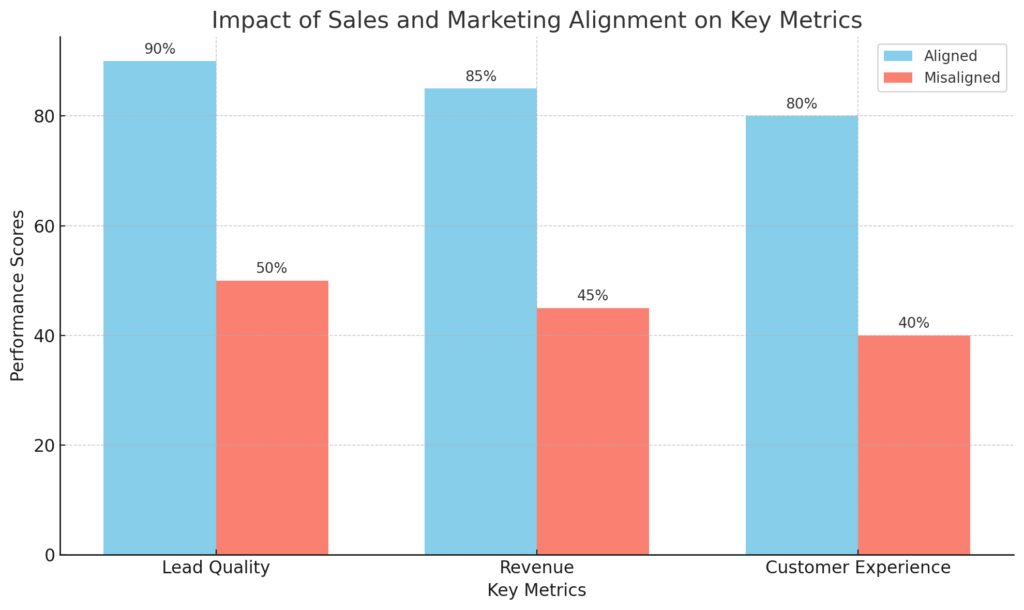The benefits to sales and marketing alignment speak for themself.
Aligning these two critical departments significantly enhances lead quality, increases revenue generating activity, and enhances customer experience. In this article, we will explore the benefits of aligning your sales and marketing teams and how it can transform your business.
In this article, you will learn:
- How sales and marketing alignment improves lead quality.
- The impact of alignment on revenue growth.
- Strategies for achieving and maintaining alignment.
Let’s dive into the details of sales and marketing alignment.
Understanding Sales and Marketing Alignment
Sales and marketing alignment refers to the process of fostering close collaboration between the sales and marketing teams within an organization. This alignment ensures that both teams work towards common goals, share data and insights, and create a cohesive strategy to drive revenue and improve customer satisfaction.
Definition and Importance
Sales and marketing alignment, often called “smarketing,” involves unified communication and mutual support between the two functions. Both teams collaborate to create customer-centered strategies that drive revenue growth and improve the customer experience. This alignment is essential because it breaks down silos, facilitates better information flow, and ensures that both teams are on the same page regarding target audiences, messaging, and objectives.
Why Sales and Marketing Alignment is Important
- Enhanced Lead Quality: When sales and marketing teams work together, they can define and identify what constitutes a qualified lead more accurately. This collaboration ensures that the leads generated by marketing are valuable to the sales team, leading to higher conversion rates.
- Increased Revenue: Aligned sales and marketing teams can create more effective strategies that resonate with target audiences, leading to increased sales and revenue. Studies show that companies with strong alignment between sales and marketing achieve higher revenue growth rates.
- Improved Customer Experience: Alignment ensures consistent messaging across all customer touchpoints, leading to a seamless and positive customer journey. This consistency builds trust and enhances the overall customer experience, making customers more likely to remain loyal to the brand.
Sales and marketing alignment is not just a buzzword; it’s a critical factor in achieving business success. By understanding its importance, companies can take the necessary steps to foster collaboration and drive growth.
Key Benefits of Sales and Marketing Alignment
Aligning sales and marketing teams offers numerous benefits that can significantly enhance business performance. Here are the key benefits of sales and marketing alignment:

Improved Lead Quality
When sales and marketing teams are aligned, they can better define what constitutes a qualified lead. This collaboration ensures that marketing campaigns are designed to attract high-quality leads that meet the criteria set by the sales team.
- Explanation: Aligned teams work together to create detailed buyer personas and target the right audience. This results in marketing generating leads that are more likely to convert into customers.
- Examples and Statistics: According to research by Demand Gen Report, organizations with aligned sales and marketing functions see a 67% increase in their ability to close deals and a 209% growth in revenue from marketing-generated leads.
Increased Revenue
Sales and marketing alignment directly impacts a company’s bottom line by creating more effective strategies that resonate with target audiences, leading to increased sales and revenue.
- Discussion: When sales and marketing teams share goals and data, they can develop coordinated campaigns that effectively nurture leads through the sales funnel. This alignment reduces friction and enhances the overall efficiency of the sales process.
- Case Studies or Success Stories: Companies like SuperOffice reported a 34% increase in revenue after aligning their sales and marketing teams. Another example is Cognism, which scaled from $3M to $50M in annual recurring revenue through effective sales-marketing collaboration.
Enhanced Customer Experience
A seamless customer journey is critical for building trust and loyalty. Sales and marketing alignment ensures consistent messaging and a cohesive strategy, enhancing the customer experience.
- Explanation: Aligned teams provide consistent and relevant messaging at every touchpoint of the customer journey, ensuring that customers receive a unified experience from initial contact to post-purchase support.
- Real-World Examples: A study by Salesforce found that 79% of customers expect consistent interactions across departments. Companies that align their sales and marketing teams can meet these expectations, leading to higher customer satisfaction and retention rates.
Sales and marketing alignment is a powerful strategy that improves lead quality, drives revenue growth, and enhances the customer experience. By focusing on these benefits, companies can unlock their full potential and achieve sustainable growth.
Measuring the Success of Sales and Marketing Alignment
To ensure that your sales and marketing alignment efforts are effective, it’s crucial to measure their success using specific key performance indicators (KPIs). These KPIs help track progress, identify areas for improvement, and ensure that both teams are working towards common goals.
Overview of Key Performance Indicators (KPIs)
Measuring the success of sales and marketing alignment involves tracking various KPIs that reflect the collaboration and performance of both teams. Here are three crucial KPIs to monitor:
- Lead Conversion Rates
- Definition: The percentage of leads converted into customers.
- Importance: High lead conversion rates indicate effective collaboration between sales and marketing teams. It suggests that marketing is generating high-quality leads and that sales is effectively closing them.
- How to Track: Regularly review lead conversion rates and analyze trends. Identify any sudden changes and investigate potential causes, such as shifts in market demand, lead quality, or sales strategies.
- Marketing Qualified Leads (MQLs)
- Definition: Leads that have been deemed more likely to become customers based on specific criteria and engagement levels.
- Importance: High-quality MQLs indicate that the marketing team is effectively targeting and nurturing potential customers. This alignment ensures that sales receives leads that are ready for direct follow-up.
- How to Track: Use your customer relationship management (CRM) platform to score leads based on traits, behaviors, and engagement levels. Regularly review the quantity and quality of MQLs to ensure alignment with sales criteria.
- Sales Accepted Leads (SALs)
- Definition: The number of leads accepted by sales as worthy of direct follow-up.
- Importance: A high SAL rate indicates that both teams agree on what constitutes a qualified lead. It reflects alignment on lead quality criteria and effective collaboration.
- How to Track: Monitor the rate at which marketing-generated leads are accepted by sales. Analyze the reasons for any discrepancies to improve the alignment process.
How to Track and Analyze These KPIs
- Regular Meetings and Communication
- Schedule regular meetings between sales and marketing teams to review KPIs and discuss performance. This fosters open communication and ensures that both teams are aligned on goals and strategies.
- Data Analysis Tools
- Utilize data analytics tools to track and analyze KPIs. CRM systems, marketing automation platforms, and data visualization tools can provide valuable insights into performance and areas for improvement.
- Feedback Loops
- Establish feedback loops between sales and marketing teams. Regularly gather input from both sides to understand challenges, identify opportunities, and make data-driven adjustments to strategies.
By measuring the success of sales and marketing alignment through these KPIs, companies can ensure that their efforts are effective and continuously improve their collaborative strategies.
Consequences of Sales and Marketing Misalignment
While the benefits of aligning sales and marketing are substantial, the consequences of misalignment can be equally detrimental. Understanding these consequences is crucial for recognizing the importance of fostering collaboration between these teams.
Wasted Resources
When sales and marketing teams operate independently, resources such as time, materials, and budget are often wasted.
- Impact: Without alignment, marketing may generate leads that sales deems unqualified, leading to wasted effort in pursuing dead-end prospects. Similarly, sales might not utilize marketing materials effectively, resulting in missed opportunities.
- Examples of Inefficiencies: For instance, if the marketing team launches a campaign that targets the wrong audience, the sales team will spend valuable time filtering through unqualified leads. This misalignment not only wastes resources but also affects team morale and productivity.
Erosion of Consumer Trust
Misalignment between sales and marketing can lead to inconsistent messaging, which erodes consumer trust.
- Impact: When customers receive conflicting messages from different departments, it creates confusion and diminishes their confidence in the brand. Consistent and coherent messaging is essential for building and maintaining trust.
- Real-World Examples and Statistics: According to a report by HubSpot, 52% of leaders cite low revenue as a significant consequence of misaligned sales and marketing functions. Inconsistent messaging can cause potential customers to lose trust in the brand, leading to decreased sales and loyalty.
Missed Opportunities
Misalignment between sales and marketing teams can result in missed sales opportunities and hinder business growth.
- Impact: When these teams are not working together, they may miss critical insights into the customer journey, leading to lost opportunities to engage and convert potential customers. This misalignment disrupts the customer experience and negatively affects return on investment (ROI).
- Case Studies or Examples: For example, if the marketing team does not communicate effectively with sales about a new campaign, sales might miss the chance to follow up with warm leads promptly. This lack of coordination can result in lower conversion rates and missed revenue opportunities.
Decreased Sales and Revenue
The most concerning impact of sales and marketing misalignment is the decrease in sales and revenue.
- Impact: Misaligned teams are less effective in driving sales, as they fail to leverage each other’s strengths and insights. This inefficiency lengthens the sales cycle and reduces the overall effectiveness of marketing efforts.
- Statistics: Research from the HubSpot 2023 Sales Trend Report indicates that companies with misaligned sales and marketing functions experience significantly lower revenue growth rates compared to those with aligned teams.
Sales and marketing misalignment leads to wasted resources, eroded consumer trust, missed opportunities, and decreased revenue. By understanding these consequences, companies can appreciate the importance of fostering alignment and take proactive steps to integrate their sales and marketing efforts.
Strategies for Achieving Sales and Marketing Alignment
Achieving sales and marketing alignment requires intentional strategies that foster collaboration and communication between both teams. Here are some effective strategies to align your sales and marketing efforts:

Regular Communication and Meetings
Regular communication is vital for maintaining alignment between sales and marketing teams.
- Importance: Frequent interactions ensure that both teams stay informed about each other’s activities, goals, and challenges. This open line of communication helps in resolving issues promptly and aligning strategies effectively.
- Tips for Effective Meetings: Schedule regular joint meetings to discuss ongoing campaigns, share insights, and review performance metrics. Use collaborative tools like shared calendars, project management software, and communication platforms to facilitate continuous dialogue.
Shared Goals and Metrics
Setting shared goals and metrics is crucial for aligning sales and marketing teams.
- Setting Common Objectives: Both teams should work together to define common objectives that align with the overall business goals. This ensures that everyone is working towards the same targets and helps in measuring success collectively.
- Aligning Metrics for Both Teams: Develop joint key performance indicators (KPIs) that both teams are accountable for, such as lead conversion rates, sales-qualified leads, and customer acquisition costs. Regularly review these metrics to ensure alignment and make necessary adjustments.
Technology and Tools
Leveraging technology can significantly enhance the alignment between sales and marketing teams.
- CRM and Marketing Automation Tools: Implementing Customer Relationship Management (CRM) systems and marketing automation platforms can streamline data sharing and improve collaboration. These tools help track customer interactions, manage leads, and measure the effectiveness of marketing campaigns.
- How Technology Facilitates Alignment: Integrated technology solutions enable both teams to access real-time data, track progress, and adjust strategies based on insights. Tools like HubSpot, Salesforce, and Marketo are examples of platforms that facilitate sales and marketing alignment.
Joint Content Creation and Distribution
Collaborative content strategies are essential for ensuring consistent messaging and effective lead nurturing.
- Collaborative Content Strategies: Both teams should work together to create and distribute content that resonates with target audiences at different stages of the buyer journey. This includes blog posts, whitepapers, case studies, and social media content.
- Examples of Successful Joint Efforts: For example, So Good Digital can develop content based on insights from sales about customer pain points, while the sales team can use this content to engage prospects and close deals. Jointly developed content ensures that messaging is consistent and aligned with the needs of potential customers.
By implementing these strategies, companies can achieve a high level of alignment between their sales and marketing teams, leading to better collaboration, more effective campaigns, and improved business outcomes.
Overcoming Common Challenges to Sales and Marketing Alignment
Aligning sales and marketing teams is not without its challenges. Addressing these common obstacles is essential for fostering effective collaboration and achieving the desired alignment.
Misalignment in Goal Setting and Metrics
One of the most significant challenges is the misalignment of goals and metrics between sales and marketing teams.
- Strategies to Align Goals and Metrics: To overcome this, both teams should collaborate on setting shared objectives and defining common KPIs. Regularly review and adjust these goals to ensure they remain aligned with the overall business strategy.
- Examples of Successful Implementations: For instance, creating a joint dashboard that tracks shared KPIs like lead quality, conversion rates, and revenue targets can help both teams stay focused on common goals.
Lack of Communication and Collaboration
Poor communication and a lack of collaboration can hinder the alignment process.
- Solutions to Improve Communication: Establish regular cross-functional meetings and use collaborative tools like Slack, Microsoft Teams, or Asana to facilitate ongoing communication. Encourage open dialogue and feedback loops between teams.
- Tools and Practices for Better Collaboration: Implementing project management software that allows both teams to track progress, share updates, and collaborate on tasks can significantly improve communication and coordination.
Inadequate Data-sharing and Integration
Siloed data and poor integration systems can frustrate efforts to align sales and marketing teams.
- Importance of Data Integration: Ensuring that both teams have access to the same data is crucial for alignment. Integrated data systems provide a single source of truth, enabling teams to make informed decisions based on accurate information.
- Examples of Integrated Technology Solutions: Utilizing integrated CRM systems, marketing automation platforms, and data analytics tools can facilitate seamless data sharing. Platforms like Salesforce, HubSpot, and Marketo offer features that support data integration and collaboration.
Creating Effective Feedback Loops
Continuous improvement requires ongoing feedback from both sales and marketing teams.
- Strategies for Regular Feedback: Implement structured feedback sessions where teams can discuss what’s working and what needs improvement. This helps in identifying gaps and making necessary adjustments.
- Examples of Feedback Implementation: For example, So Good Digital sets up routine review meetings where sales and marketing stakeholders analyze recent campaigns, share customer feedback, and discuss future strategies can help maintain alignment and improve performance.
By addressing these common challenges and implementing effective strategies, companies can foster a stronger alignment between their sales and marketing teams. This alignment is crucial for driving better results, improving efficiency, and achieving business growth.
Conclusion
Aligning sales and marketing teams is crucial for enhancing lead quality, increasing revenue, and improving the customer experience. By understanding the benefits and addressing common challenges, companies can foster a more collaborative and effective working relationship between these essential departments.
Summary of Key Takeaways
- Improved Lead Quality: Sales and marketing alignment ensures that marketing generates high-quality leads that are more likely to convert, leading to more efficient and successful sales efforts.
- Increased Revenue: Aligned teams can develop coordinated strategies that drive revenue growth, as evidenced by companies like SuperOffice and Cognism.
- Enhanced Customer Experience: Consistent messaging and a seamless customer journey improve customer satisfaction and loyalty, leading to long-term business success.
By focusing on these areas and implementing the strategies discussed, companies can unlock the full potential of their sales and marketing teams, driving growth and achieving their business objectives.



